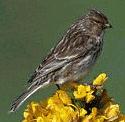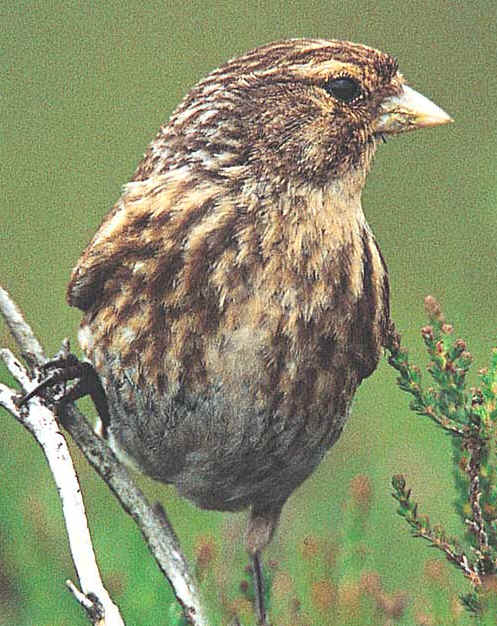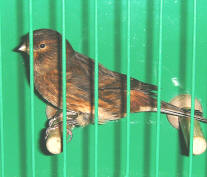 |
TWITE CROSSES The Twite is very closely related to the Linnet and is called the mountain Linnet the main difference between the Twite and the Linnet is the beak. Twites have very short beaks and no pink chest. Cock Twites have a red rump the Twite hen doesn't, other than that both sexes are similar. Usually 5 to 6 eggs, they hatch 12 or so days after sitting occurs, young leave the nest at approx 15 days, young are self supporting at approx 28 days old
|

|
|
BREEDING PAGES CLICK HERE |
||
|
Status and distribution In the Western Palearctic
occurs in two widely separated areas: in coastal areas of the north-west and in the
region of the Caucasus.
In north-western Europe breeds in the Faroes and northern & western
British Is
and from southern Norway north in coastal areas to Varangerfjord and the
Kola Peninsula.This population is resident or partially migratory in
the south and fully migratory north
of the Arctic Circle. Migrants leave breeding areas in late Sep-Oct to
winter from
southern England to Denmark, southern Sweden and Baltic coasts to southern
Finland, returning
in Mar-Apr. Also recorded further south in Spain, southern France, Hungary
and
Romania.Eastern population breeds in east & south-east Turkey and throughout
the
Caucasus, mainly an altitudinal migrant extending range in winter to Central
Turkey.Recorded as a vagrant on Sicily.
Subspecies Nominate race occurs in Fenno-Scandia replaced by warmer brown pipilans in British Is but the two are very similar in worn plumage. Caucasian race brevirostris is more distinct, paler above and on face with pale pink rump and broad dark streaks on sides of otherwise whitish breast. Habitat In north-western Europe breeds on open moorland, usually coastal, sometimes in mountains, in areas of rocky grassland and dwarf birch. Winters in lower, often coastal areas of open land with weeds and scattered rocks and bushes, sometimes on pastures and in reed beds. Caucasian birds breed on high plateaux, on scree slopes and cliffs, in alpine meadows and sparsely-vegetated hillsides. In winter generally in lower areas of plains and valleys
|
||
|
|
TWITE X CANARY
very nice cross one of my favorites, best using the Norwich canary and colour fed makes a good show bird Twite mules are darker than the linnet mule and there beaks are pale. bird bred by Ron Phillips
|
|
|
NO PICTURE AVAILABLE AT THIS TIME IF YOU CAN HELP WITH ONE PLEASE EMAIL ME |
TWITE X GREENFINCH Again both being similar brown based birds there is little point in wasting birds in this pairing, other than the achievement of breeding a hybrid, they are quite easy to breed, again may be enhanced in the many colour variant forms possible by using the Greenfinch cock to produce colour variant hens but easier bred using the Twite cock as the greenfinch cock is not so ready to interbreed
|
|
 |
TWITE X REDPOLL Picture supplied by Aux Fringill'idees http://stephane.schlub.free.fr/" both being similar brown based birds there is little point in wasting birds in this pairing, other than the achievement of breeding a hybrid, they are quite easy to breed, again may be enhanced in the many colour variant forms possible by using the Redpoll cock to produce colour variant hens. although they do show there parentage well. |
|
|
TWITE X
GOLDFINCH Sid Humphries bred this Cross using the Twite hen in 1961 according to an article in Cage & aviary Birds, From the front view it looks exactly like a young Greypate Goldfinch, but side view this promising youngster resembles a young Twite except for the wingbars and buttons, which are somewhat darker than those of pure Goldfinch. There is also some bright yellow on the flights. The bird appears to be a cock and should later show some signs of a blaze, although this maybe a small as in the Goldfinch x Linnet cross. |
||
|
TWITE FEEDING TECHNIQUES SEED: good British finch mix including a small amount of hemp, pine nuts, niger, maw, gold of pleasure also a good multi vitamin with added probiotic. REARING: soaked seed, egg food, a supply of green food and small amounts of live food, when rearing young, fresh water daily and mineralised grit with a small amount of charcoal added.
|
||
